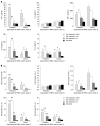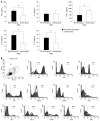Probiotic Bio-Three induces Th1 and anti-inflammatory effects in PBMC and dendritic cells
- PMID: 20653061
- PMCID: PMC2909552
- DOI: 10.3748/wjg.v16.i28.3529
Probiotic Bio-Three induces Th1 and anti-inflammatory effects in PBMC and dendritic cells
Abstract
Aim: To investigate the immune response of peripheral blood mononuclear cells (PBMCs) and dendritic cells (DCs) that were stimulated by probiotic preparations.
Methods: PBMCs were isolated, cultured, and stimulated with Bio-Three (a mixture of Bacillus mesentericus, Clostridium butyricum and Enterococcus faecalis; 10(5), 10(6) and 10(7) CFU/mL for 24 h). Cytokine production of (1) circulating PBMCs; (2) PBMCs stimulated by probiotic preparation; (3) monocyte-derived DCs; and (4) DC and T cell co-culture was determined by enzyme-linked immunosorbent assay. Phenotypic analysis of circulating PBMCs was also investigated by flow cytometry. Blood was obtained from individuals who consumed Bio-Three (10(9) CFU/d B. mesentericus, C. butyricum and E. faecalis) for 2 wk, or those who did not take probiotics orally.
Results: In culture supernatants, interferon-gamma (IFN-gamma) and interleukin (IL)-10 production increased, but IL-4 and tumor necrosis factor-alpha (TNF-alpha) production by PBMCs decreased after 1 and 2 wk of probiotic treatment. Flow cytometry was also performed on day 14 and detected enhanced expression of CD11b, HLA-DR, CD4, CD45RA, CD25, CD44 and CD69 in response to Bio-Three. Furthermore, IL-10 and IL-12 were upregulated in supernatants of monocyte-derived DCs, and IFN-gamma and IL-10 were enhanced in supernatants of CD4(+) T cells co-cultured with DCs.
Conclusion: Bio-Three appeared to stimulate the Th1 immune response, downregulate pro-inflammatory cytokines (TNF-alpha) and upregulate anti-inflammatory cytokine (IL-10). Probiotics could be effective in activation of PBMCs and DCs.
Figures








Similar articles
-
Uncarinic acid C plus IFN-γ generates monocyte-derived dendritic cells and induces a potent Th1 polarization with capacity to migrate.Cell Immunol. 2010;266(1):104-10. doi: 10.1016/j.cellimm.2010.09.004. Epub 2010 Sep 18. Cell Immunol. 2010. PMID: 20933226
-
Dendritic cells partially abrogate the regulatory activity of CD4+CD25+ T cells present in the human peripheral blood.Int Immunol. 2007 Mar;19(3):227-37. doi: 10.1093/intimm/dxl139. Epub 2007 Feb 7. Int Immunol. 2007. PMID: 17289657
-
Effect of Eucommia ulmoides Oliv., Gynostemma pentaphyllum (Thunb.) Makino, and Curcuma longa L. on Th1- and Th2-cytokine responses and human leukocyte antigen-DR expression in peripheral blood mononuclear cells of septic patients.J Ethnopharmacol. 2018 May 10;217:195-204. doi: 10.1016/j.jep.2018.02.024. Epub 2018 Feb 17. J Ethnopharmacol. 2018. PMID: 29462699
-
Portrait of an immunoregulatory Bifidobacterium.Gut Microbes. 2012 May-Jun;3(3):261-6. doi: 10.4161/gmic.20358. Epub 2012 May 1. Gut Microbes. 2012. PMID: 22572827 Free PMC article. Review.
-
A bibliometric analysis: Ca2+ fluxes and inflammatory phenotyping by flow cytometry in peripheral blood mononuclear cells.Front Immunol. 2023 Oct 13;14:1272809. doi: 10.3389/fimmu.2023.1272809. eCollection 2023. Front Immunol. 2023. PMID: 37901222 Free PMC article. Review.
Cited by
-
The gut microbiota can be a potential regulator and treatment target of bone metastasis.Biochem Pharmacol. 2022 Mar;197:114916. doi: 10.1016/j.bcp.2022.114916. Epub 2022 Jan 15. Biochem Pharmacol. 2022. PMID: 35041811 Free PMC article. Review.
-
Lacticaseibacillusparacasei BNCC345679 revolutionizes DSS-induced colitis and modulates gut microbiota.Front Microbiol. 2024 Mar 27;15:1343891. doi: 10.3389/fmicb.2024.1343891. eCollection 2024. Front Microbiol. 2024. PMID: 38601942 Free PMC article.
-
Lactobacillus fermentum species ameliorate dextran sulfate sodium-induced colitis by regulating the immune response and altering gut microbiota.Gut Microbes. 2019;10(6):696-711. doi: 10.1080/19490976.2019.1589281. Epub 2019 Apr 3. Gut Microbes. 2019. PMID: 30939976 Free PMC article.
-
α-Lipoic acid increases phagocytosis of some lactic acid bacteria via modulation of CD36 expression.Biosci Microbiota Food Health. 2025;44(1):43-48. doi: 10.12938/bmfh.2024-019. Epub 2024 Aug 21. Biosci Microbiota Food Health. 2025. PMID: 39764493 Free PMC article.
-
The Role of the Gut Microbiota in Individuals with Irritable Bowel Syndrome: A Scoping Review.Medicina (Kaunas). 2024 Nov 19;60(11):1895. doi: 10.3390/medicina60111895. Medicina (Kaunas). 2024. PMID: 39597080 Free PMC article.
References
-
- Madsen K. Probiotics and the immune response. J Clin Gastroenterol. 2006;40:232–234. - PubMed
-
- Vaarala O. Immunological effects of probiotics with special reference to lactobacilli. Clin Exp Allergy. 2003;33:1634–1640. - PubMed
-
- Isolauri E, Sütas Y, Kankaanpää P, Arvilommi H, Salminen S. Probiotics: effects on immunity. Am J Clin Nutr. 2001;73:444S–450S. - PubMed
-
- Kalliomäki MA, Isolauri E. Probiotics and down-regulation of the allergic response. Immunol Allergy Clin North Am. 2004;24:739–752, viii. - PubMed
-
- Michail S, Sylvester F, Fuchs G, Issenman R. Clinical efficacy of probiotics: review of the evidence with focus on children. J Pediatr Gastroenterol Nutr. 2006;43:550–557. - PubMed
Publication types
MeSH terms
Substances
LinkOut - more resources
Full Text Sources
Research Materials
Miscellaneous

